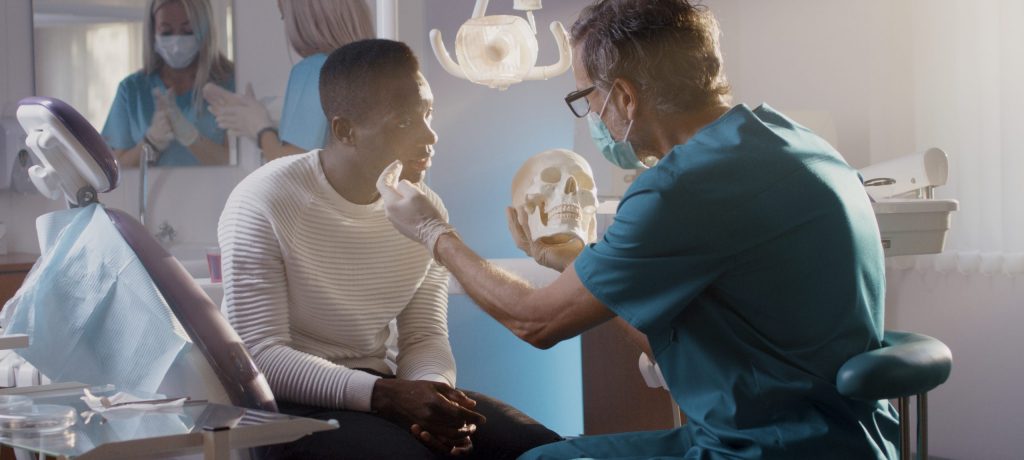Information Library
Start Reading

Do you worry about going to the dentist? Between 50% and 80% of U.S. adults experience some degree of dental anxiety. Extreme anxiety becomes dental phobia—an overwhelming fear that can lead people to avoid dental treatments altogether.

For individuals with physical, intellectual, or developmental disabilities, dental phobia and anxiety can be especially difficult. Studies suggest dental phobia and anxiety contributes to higher rates of poor oral health among these individuals than among the general population.
Effective dental anxiety management can make a dental visit feel a lot less scary for all patients, including those with disabilities. You or the patient in your charge as well as your dentist can do things to make dental appointments less intimidating, overwhelming, or frightening.
Autism spectrum disorders (ASD), Down syndrome, cerebral palsy, and other disabilities pose challenges to an individual’s sensory processing systems. These disorders make it harder for the body’s systems to interpret, organize, and respond to the sensory input they receive. As a result, disorders and disabilities cause hypersensitivity to lights, sounds, physical contact, and other stimuli.
For example, consider a trip to the dentist from the perspective of an ASD patient.

Everyone benefits from some level of routine. People with autism find routine essential. Repetition, predictability, and consistency help them feel safe and in control. Routine can also help them master essential life skills, a benefit especially important for children with autism.
Dental appointments disrupt everyday routines. Dental offices are full of sensory stimuli that can overwhelm and overstimulate. Dental operating lights are bright. Drills are high-pitched and loud. Feeling the hygienist’s or dentist’s hands in your mouth can be strange and unpleasant.
Additionally, patients with disabilities like ASD may have had previous negative experiences in dental offices. The National Council on Disability conducted a 2017 survey in which 75% of dental students reported receiving “little to no preparation” in caring for patients with intellectual and developmental disabilities.
Reasons for dental fear are understandable; however, getting regular dental care is crucial to oral and overall health, so dental anxiety management is crucial, too.
Patients, their caregivers (as applicable), and dental professionals all have parts to play in dealing with dental fear.
If dental fear overwhelms you or the patient in your charge, talk about it openly and without judgment. If you’re not sure, ask them. If a patient with disabilities is non-verbal, be alert for signs indicating they feel agitated or upset about dental treatments.
You can also inform dental care providers. They can be ready to help ease the patient’s anxiety. They may even suggest anxiety management approaches you hadn’t considered.

Patients with disabilities should be told in advance as much detail as possible what to expect during dental appointments. Social stories—simple, step-by-step descriptions of a new situation—often help ASD patients. Roleplay may also prove useful.
Dentists, too, should be able to use the “Tell-Show-Do” technique, a type of exposure therapy that uses pictures or objects to gradually expose patients to dental procedures.
Deep breathing exercises and other mindfulness techniques can help put patients at ease. Practice inhaling and exhaling slowly and methodically at home, for instance. Repeat this deep breathing in the waiting room or during breaks in the dental chair.
Meditation at home before the visit and listening to music via headphones during the visit may also help patients undergo dental appointments with less apprehension and stress.
Some dental professionals are quick to use general anesthetic on patients who have trouble tolerating standard treatment.
PDM does not recommend or follow this practice. We make patients’ experience less frightening and more comfortable while they stay awake. If they are denied the chance to experience dental procedures, those procedures can never become routine, and future dental anxiety management becomes all the more difficult.
In some cases, though, other sedation can help. Conscious sedation blocks pain and puts patients at ease. Nitrous oxide inhalation analgesia is another option, and one we use at PDM. It proves effective for 75%-80% of patients with disabilities.
If you’re near a dentist known for autism-friendly and other disability-friendly care, make an appointment. You may be able to make “pre-appointments” to meet staff, see dental equipment, and sit in the dental chair before returning for treatment. (General dentists may also offer pre-appointments—be sure to ask).
A dental anxiety specialist will have offices designed for physical accessibility and decorated to reduce overstimulation. The dentist will have specialized clinical training and experience treating patients with disabilities, increasing the likelihood of a positive experience.
At Penn Dental Medicine (PDM), our dental team provides patient-centered care and does everything within their power to calm dental anxiety.
We treat patients younger than age 14 in our Pediatric Care Center. We treat those who are older in our Care Center for Persons with Disabilities. It includes several features designed to facilitate comfortable, effective dental treatment for these patients, including:
To find out more about PDM’s approach to dental anxiety management for patients with autism and other disabilities, download our free eBook, Overcoming Oral Health Barriers for People with Disabilities. It will show you how we’re helping people with disabilities get the high quality, anxiety-reducing dental care they need and deserve.